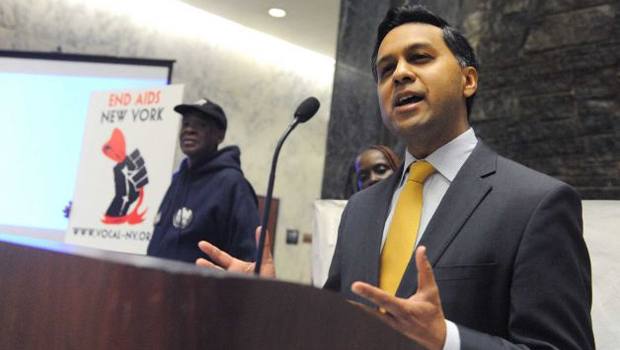
Article via Times Union
Albany
The state has negotiated a deal with a major pharmaceutical company to cut the price of anti-retroviral drugs to treat HIV, state Health Commissioner Nirav R. Shah said Wednesday.
The move is part of an evolving state plan to reduce the number of New Yorkers infected with the virus that causes AIDS.
On Wednesday, Shah told cheering AIDS activists at the Legislative Office Building that the state aims to cut the number of newly diagnosed cases from about 3,400 in 2012 to under 730 by 2020.
About 130,000 New Yorkers currently live with HIV or AIDS.
Activists said the deal with California-based drugmaker Gilead Sciences Inc., which Shah estimated has a 40 percent market share in anti-retrovirals for HIV, should push other manufacturers to follow suit.
State health officials are “doing a very bold move of pressuring drug companies to lower the price of AIDS drugs,” said Sean Barry, executive director of New York City-based Voices of Community Activists and Leaders (VOCAL-NY).
The state is a high-volume purchaser of the drugs. More than 60,000 New Yorkers with HIV are covered by the government-sponsored Medicaid program. More may seek HIV testing or treatment with the expansion of Medicaid through the Affordable Care Act.
Controlling the illness and its spread is cost-effective, the health commissioner said.
“Every new case of HIV results in $379,000 in additional lifetime costs” to treat the patient, Shah said.
Other goals, he said, include reducing by half the number of New Yorkers progressing from HIV to AIDS and addressing social conditions that contribute to the prevalence of the disease among low-income people.
Key to reaching the objectives is increasing the number of New Yorkers with HIV who have the virus under control, said Dan Tietz, executive director of the New York City-based AIDS Community Research Initiative of America. This means they are receiving treatment, retain an undetectable level of the virus and have a minimal chance of infecting others. Tietz called for doubling the percentage of patients who fall into this category, now at 40 percent to 50 percent of infected people.
Shah touted the progress made fighting AIDS in New York, which was “the leading incubator of the disease” 30 years ago, he said. Prevention and treatment efforts have led to a 40 percent reduction of new HIV cases and AIDS-related deaths in the last decade. Out of 240,000 births in New York last year, just two babies were born with HIV transmitted from their mothers, he said.
The state’s plan also would simplify the consent needed for HIV testing — from written to verbal — and the sharing of medical data, Shah said.
The health commissioner’s remarks were met with deafening applause and exuberance — a far cry from the antagonism in past interactions between state officials and AIDS activists.
“That Dr. Shah can stand there and get this applause is another step forward — it’s huge,” Barry said.
Gov. Andrew Cuomo’s proposed state budget calls for $9 million to support a rent cap for disabled New York City residents with AIDS.
With the Gilead deal sealed, the governor may disclose further details of the state’s plan to reduce HIV infection to point where the virus would no longer be deemed epidemic, Shah said.
“It’s going to happen,” Shah said. “It’s a matter of ‘when,’ not ‘if.'”
Note: This article does not necessarily represent the opinions of Paul Morris or Treasure Island Media. We felt it right to post, allowing each of you to digest, and form your own opinion. We look forward to hearing what you think.













